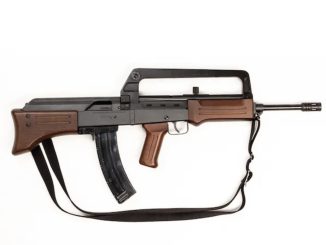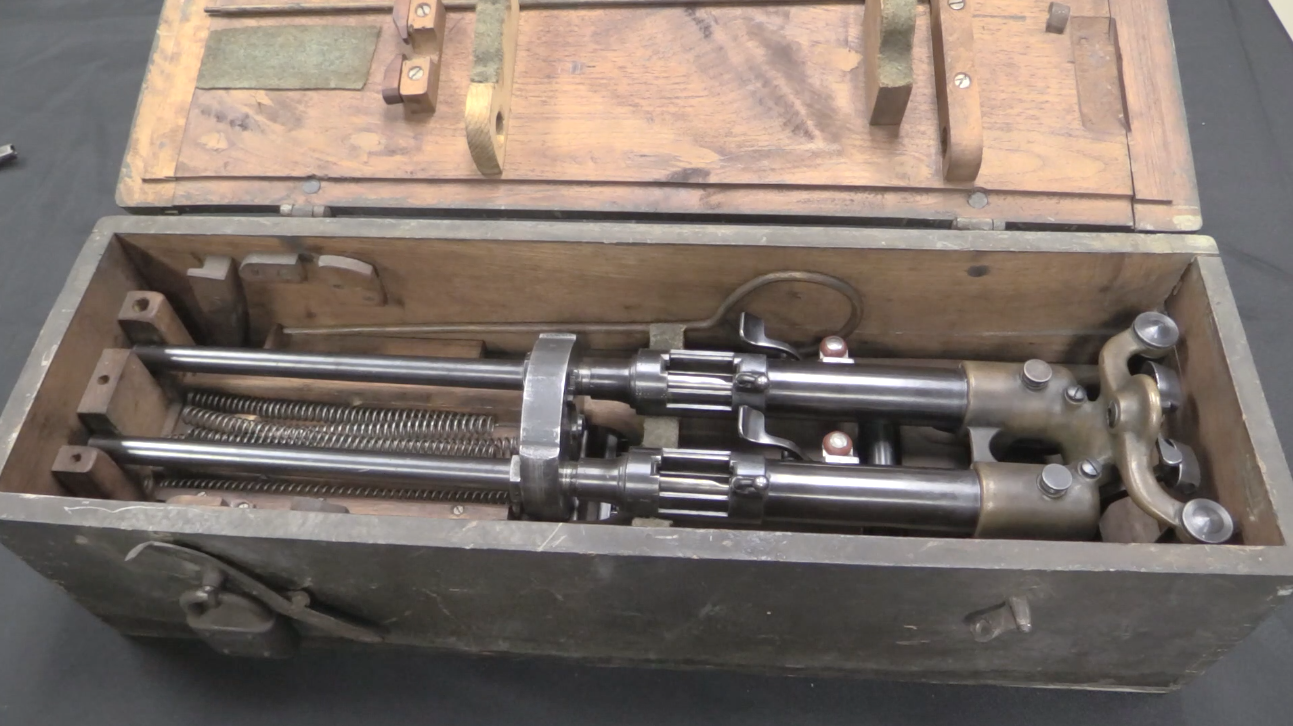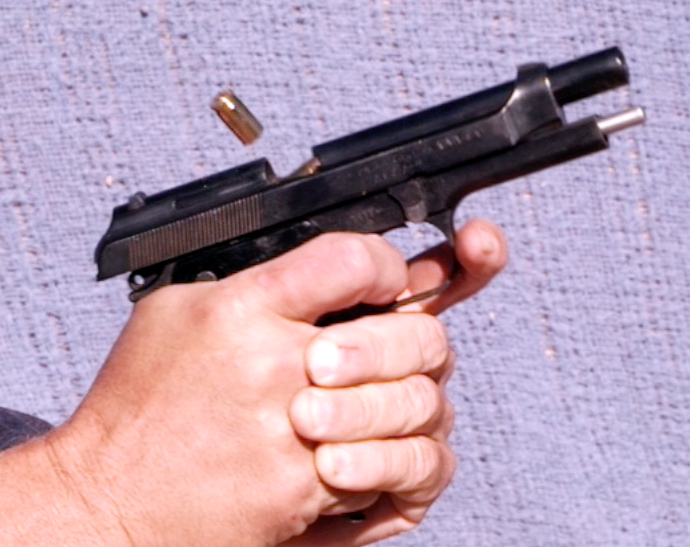Introduced by the Italian Pietta company in the 1970s (yes, the same Pietta that makes all those reproduction Old West revolvers and lever action rifles), the PPS/50 has been a continuously popular firearm for more than 40 years now. Designed to roughly resemble a Soviet PPSh-41 submachine gun, the PPS/50 is a semiautomatic .22 rimfire for the recreational market and nothing more. It is a simple blowback action, and perhaps the most interesting mechanical feature is its 50-round drum magazine (which is really what differentiates it from the plethora of other rimfire semiautomatic rifles on the market). The drum is remarkably reliable, and has certainly contributed to the long sustained manufacture of the PPS/50.
Related Articles

Reproduction
Armi Jager AP85: An Italian .22 Rimfire Faux-MAS

Aircraft MGs
M1915 Villar Perosa Video

Semiauto pistol

I’m such a fan of all things rimfire, I need to find one of these.
“rimfire”
.22 rim-fire is curiosity for me: living fossil, which is highly popular.
Why fossil? It is rim-fire, most rim-fire cartridge become extinct looong time ago.
Additionally it is outside lubricated unlike most modern cartridge which are inside lubricated.
It also has a “heeled” bullet, the front of the case and the front end of the bullet are the same diameter.
The bullet has a reduced diameter “heel”/shank that fits inside the case.
The unfortunate sudden start that the bullet gets from all of the priming compound that rimfire requires to actually work, expands the shank up to full diameter.
This is bad for accuracy potential, however rimfire target competition ensures that most manufacturers of ammunition take good care.
It’s not that. 22lr iso inherently accurate, it’s not!
It’s just that some centrefire is very crappily made, because manufacturers don’t think that customers will find out. With 22lr it’s more likely to be fired at targets out of semi decent rifles
I should add that outside lubricated apply for .22 Short, .22 Long and .22 Long Rifle, but there exist inside lubricated .22 rim-fire cartridges: .22 WRF and .22 WMR.
It is interesting that in early 20th century U.S. manufacturers introduced .22 rim-fire self-loading rifles with proprietary cartridges, namely:
Winchester Model 1903 firing .22 Winchester Automatic http://municion.org/22altres/22wrfa.htm
Remington Model 16 firing .22 Remington Autoloading http://municion.org/22altres/22warf.htm
one answer why might be fact that at time they were introduced (Winchester – 1903, Remington – 1914), black-powder iterations of .22 Short/Long/Long Rifle were still available and self-loading rifles don’t like black-powder. I suspect, that it also give more positive seating of bullet in case, which should be advantage from point-of-view of reliability, also such solution prevented loading say .22 Short instead .22 Long Rifle, which might prove too weak to cycle action.
Some time later, both decided about introducing .22 Long Rifle self-loading rifle: Winchester Model 63 (redesign of Model 1903)
Remington Model 24 (not linked to Model 16)
Some time later, Remington introduced their Model 550 which (according to manual): Shoots .22 Short, Long, and Long Rifle Cartridges Interchangeably and Automatically without Adjustment
Easy enough, they are still being made. https://www.emf-company.com/store/pc/PPS-50-c543.htm
“Designed to roughly resemble a Soviet PPSh-41 submachine gun, the PPS/50 is a semiautomatic .22 rimfire for the recreational market and nothing more. It is a simple blowback action, and perhaps the most interesting mechanical feature is its 50-round drum magazine (which is really what differentiates it from the plethora of other rimfire semiautomatic rifles on the market).”
Red Army used .22 rim-fire machine gun for training, short description in English:
https://en.wikipedia.org/wiki/Bl%C3%BCm_machine_gun
more detail in Russian:
http://alex—1967.narod.ru/SMALLCALIBERMASGUN_1.pdf
Drawings are as follow [low-caliber = .22 rim-fire]
1) low-caliber “drop-in” machine gun, inside Maxim machine gun
2) mounted low-caliber machine gun, pattern 1930
3) mounted low-caliber machine gun, high position
4) mounted low-caliber machine gun, low position
5) magazine with cover removed [its capacity was 39, notice similarity with Pietta magazine]
7) tank low-caliber machine gun, with ball-mount (literally “apple” mount)
8) tank low-caliber machine gun itself
8) light low-caliber machine gun [externally make in way to mimic DP]
9) aviation low-caliber machine gun
10) low-caliber machine gun attached to DP light machine gun
11) parts used to attach low-caliber machine gun to Maxim machine gun
12) parts used to attach low-caliber machine gun to DP machine gun or its wooden mock-up
13) wooden mock-up of DP with attached low-caliber machine gun
14) and 15) details of tank low-caliber machine gun
16) low-caliber carbine-machine gun [this is closes to PPS 50, carbine-machine gun is early Russian term for sub-machine gun, later replaced by pistol-machine gun]
interestingly both weapons seems to share magazine principle of operation.
How does one load cartridges into the magazine? And how does it compare with the pan-fed American 180 in terms of practical usage? Would this gun be a good training weapon?
Regarding high capacity .22 rim-fire magazines, early Owen design (of Australian OWEN sub-machine gun) is worth of note, see 1st photo from top:
http://www.thefirearmblog.com/blog/2014/02/03/evelyn-owens-homebuilt-22-smg/
my first though was: looks steam-punk like and how it does actually works?
It looks to be just peculiarly-shaped revolver, however the power to rotate cylinder (ring?) seems to be provided by clock-spring-like spring, caliber is stated to be .22 Short, capacity of that thing is not given, but after examining I guess it is 45 or so.
Considering low pressure of .22 short it might be viable solution, even today, for high-capacity magazines for .22 short weapons.
This sparked question to me: how big .22 short cylinder would be for given capacity?
All steel-cylindered revolvers are compliant with so-called Barlow formula
https://www.engineersedge.com/calculators/pipe_bust_calc.htm
(don’t be afraid it says it is for fluids)
in form as given in link, it allow calculation how big pressure in cartridge you need to burst cylinder, providing diameter of chamber, thickness of walls and type (ultimate tensile strength) of steel, however it can be transform to answer question: how thick walls should be for given cartridge, cartridge diameter and steel.
I replaced SF with F for clarity and replaced OD (outside diameter) with I+2*T (I for internal diameter), after transforming I got as follows:
T = (P*I*F)/(2*S-2*P*F)
Assuming F to be 1.5, I to be .22 and S to be 58000 (minimum ultimate tensile strength for A36), P to be 21000 (maximal pressure for .22 Short) result is: ~ 0.1308.
This mean that distance between axises of following chambers should be 0.3508 inch.
This mean diameter (taken between cylinder axis and cartridges axis, not overall diameter!) will be roughly x*0.3508/3.1415 that is x*0.117 where x is capacity (quantity of cartridges), so for 50 cartridge it would give 5.85″.
Two ways, one through the feed lips, but it’s better to take the back off so the rims overlap correctly (video link below). Otherwise, the gun is a jam-o-matic.
https://www.youtube.com/watch?v=2IlgeILzcu4
Talk about memories.Back in the early 80’s a gun mag. called FIRE appeared and one of the early articles was about a full auto conversion of this gun
This was befor the machine gun bill in the US and down in Georgia a company called Hard Time Armories was doing legal full auto conversions of this gun and others
This was the period when you could buy drop in auto sears out of the shotgun news for under 50 dollars including a BATF form in order to register it in your name ha ha
We canadians were so jealous
Funny thing was here in France in the late 80’s some one was advertizing le
gal full auto parts_for the mini 14 just like in the Palladin Press book but then the law changed and I missed out on that to
And were recalled by the importer – Ruko- as they were ”easily convertable” in the early ’90’s
The PPS-50 was designed by John Farmer of Hard Times Armory with auto conversion in mind. If you disassemble an original, you will notice that the stock is inlet for pieces that aren’t there.
The firing mechanism is based on the Armalite AR-7.
Some early ones had a problem with the timing of the disconnect/main sear engagement. Any wear on the engaging edges, and more than one round might fire. There was a recall.
The drum is loaded one round at a time, a little steel loading tool (bent wire) being used to force the top round down, allowing the next to be inserted. More recent drums are plastic, and can be loaded without the tool.
Really should have been named the PPD-22, but that wouldn’t sell as well.
Thank you for the tip- I have one and it might happen to me!
As Dikk indirectly indicates, it does look rather more like a PPD 34/38 than a PPSh 41. But then, who besides weapons nerds know the PPD at all?
Ii do, and it’s driven me nuts since we sold these puppies through Mitchell Arms at the long defunct Meredith’s Gun Shop in the early 1980’s!!!
Sorry, “Dick”. I hate typing on glass keyboards.
Mitchell at the time, imported this gun, an AK22 (with much closer aesthetics than current incarnations, AR style .22’s, (which did not seem to be Armi Jaeger, and certainly not that Philippine contraption ), and of all things, a FAMAS .22…crazy days back then.
Where are you located? I’ve got one that shoots great. Picked it up from a friend I don’t need it. Wood stock has a crack on each side. Does not have bAnjo mag. Banana mag only. I’m in Oklahoma. Synthetic stocks are available.
$200 http://www.e-sarcoinc.com/ppsh41-22-semi-auto-rifle-in-22-lr.aspx
Had my Pietta out this weekend with several other gins and the Pietta was the only one that I shot. I use an original stick mag and a plastic Black Dog mag and it’s without a doubt the most fun gun I own. I do have a drum mag but haven’t felt the need to use it. Would not ever consider selling it.